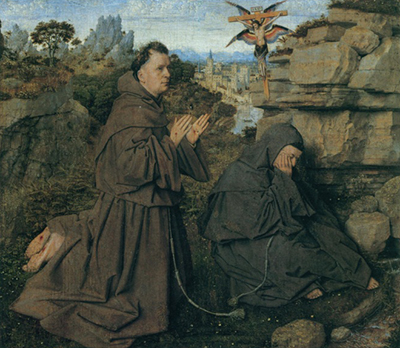Jan van Eyck produced two near identical paintings of St Francis Receiving the Stigmata during the period of 1428–1432. One of those can be found in the Philadelphia Museum of Art, whilst the piece we discuss here is located in the collection of the Sabauda Gallery, Turin, Italy.
This version in Turin is much larger than the other, but they contain very similar detail that can only be contrasted through a serious examination of both canvases. We do know that as early as 1470 both paintings were under the ownership of the same individual, suggesting that he had bought the two together directly from the artist. Quite why two versions were produced, we are not sure. It may have been that they were to be hung in different locations of the same building, and more related to available space rather than any technical or artistic decisions from van Eyck himself. Several historians have claimed that these might not be from the hand of this artist, but the overwhelming concensus is that they indeed both are, and that seems unlikely to be challenged again. Attributions to this artist have often been controversial, though these are some of the few works that we can fairly confidently claim to be his.
Saint Francis of Assisi receives the stigmata whilst kneeling upon a rocky landscape. Behind we can see a busy city as well as some more hilly regions close by. The artist sets the scene beautifully by spending a large amount of time in detailing the background and it becomes an important part of the work as a result. This attention to detail ensures a longer life for these paintings and means that we regularly will refer back to Van Eyck's work in order to see new elements each time. Most would initially only concentrate on the two figures in the foreground. He also would practice and research his details in a way that ensured an integrity, rather than simply focusing on producing something pretty but inaccurate to reality. His tiled floors, for example, were based on designs from Spain that would have been found in his own part of Europe at that time.
The Sabauda Gallery hosts one of the best collections of work by the old masters and features prominent paintings with some sculptures too. There are two main regions covered here, Italy as one would expect, but also the Dutch and Flemish regions around Northern Europe. You will therefore find plenty of artists loosely related to the career of Van Eyck here, and perhaps can expand your knowledge of this period with a visit to this fine institution. Some of the artists to look out for here include Andrea Mantegna, Orazio Gentileschi, Rogier van der Weyden, Paolo Veronese and also Duccio di Buoninsegna, the latter of which actually came about even earlier than Van Eyck and would become an important influence on the direction of Italian art.




